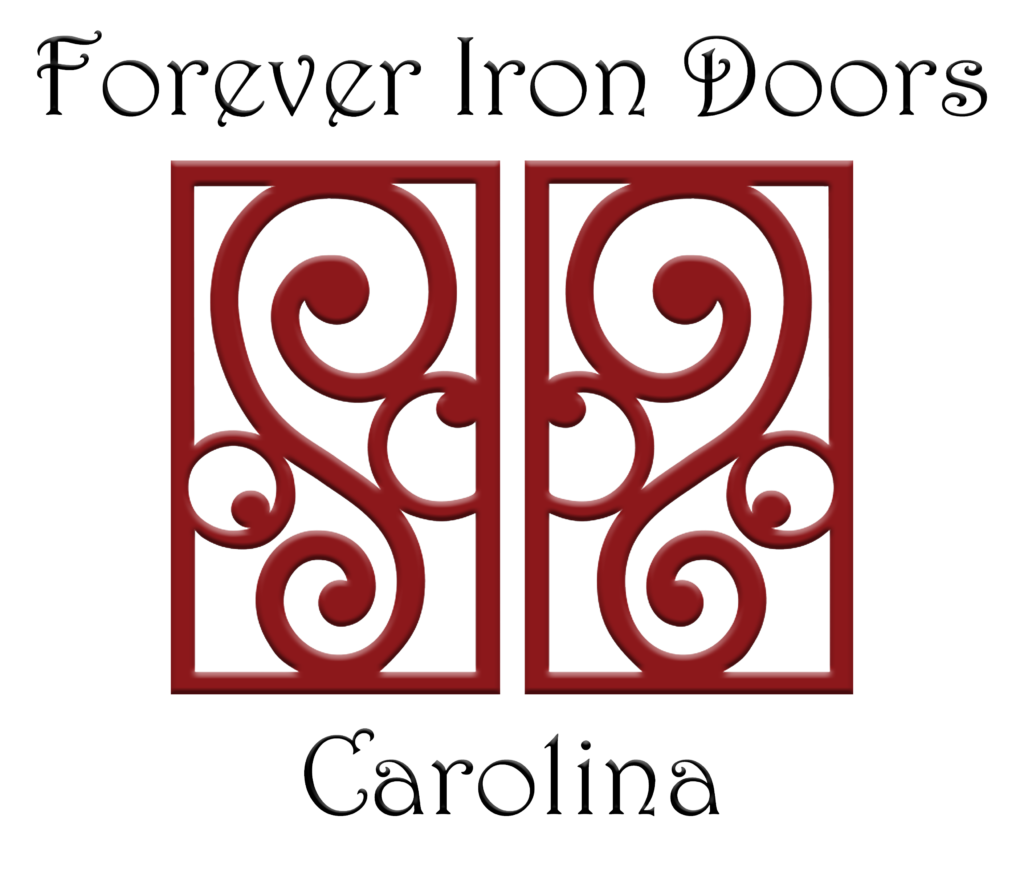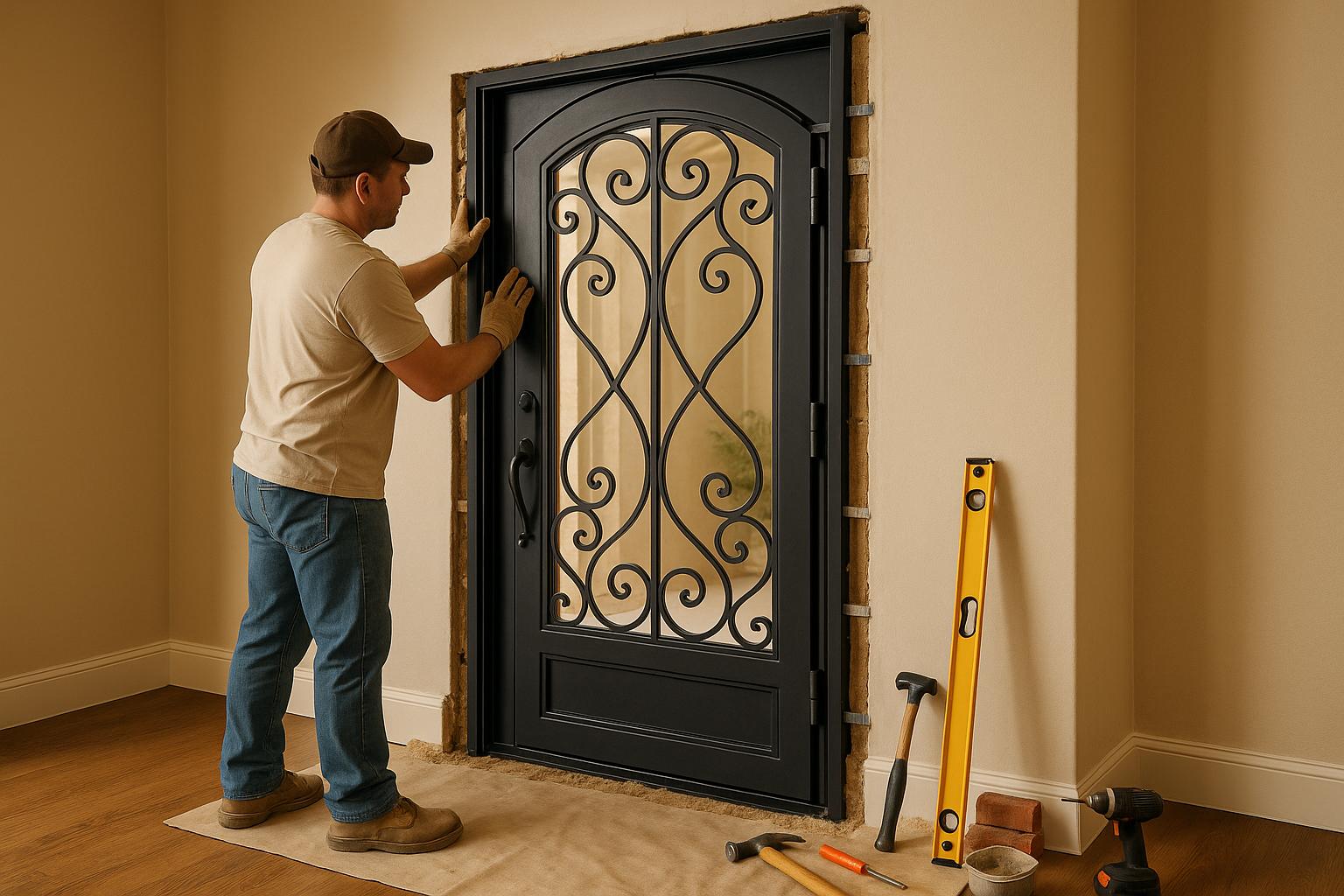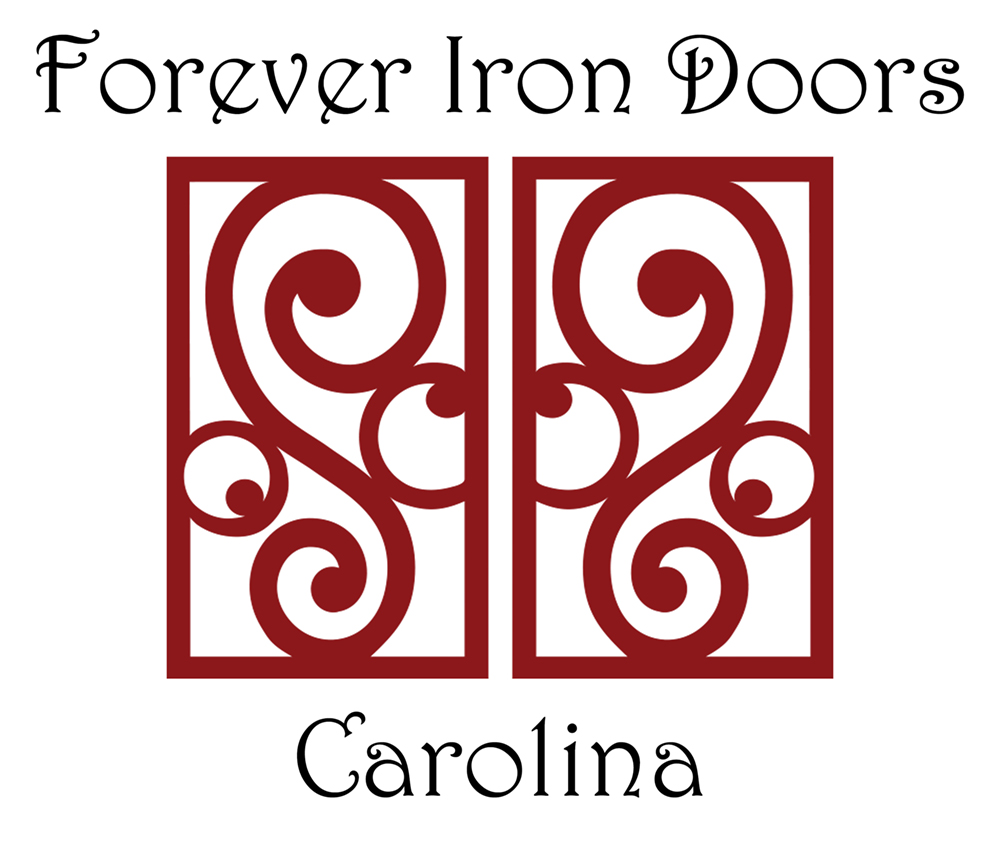Installing a wrought iron door in your home isn’t just about aesthetics – it’s a structural challenge. These doors, often weighing 150–300 pounds, can strain walls and frames, particularly when installed in load-bearing walls. Missteps can lead to sagging ceilings, unstable walls, or even structural failure. Here’s what you need to know:
- Weight Matters: A wrought iron door is significantly heavier than standard wooden doors, requiring reinforced frames and specialized hardware.
- Load-Bearing Walls: These walls support your home’s structure by transferring weight to the foundation. Altering or installing doors in these walls without proper planning risks structural damage.
- Reinforcement Is Key: Adding support beams, upgrading hardware, and ensuring the frame can handle the load are critical steps.
- Professional Help: Consulting a structural engineer or hiring experts, like Forever Iron Doors Carolina, ensures safety and compliance with building codes.
Whether you’re planning a DIY project or hiring professionals, understanding the structural demands of wrought iron doors is essential for a safe and durable installation.
Understanding Load-Bearing Walls
Before diving into your iron door installation project, it’s important to grasp what makes a wall load-bearing and how to identify one. This knowledge is critical because altering or removing a load-bearing wall without proper precautions can lead to serious structural damage or even collapse. Let’s break it down.
What Are Load-Bearing Walls?
Load-bearing walls are the backbone of your home. Unlike walls that simply divide spaces, these walls are structural elements that carry the weight of the building. They support vertical loads from above – like floors, roofs, and their own weight – and transfer that weight down to the foundation, ensuring the stability of the entire structure.
Here’s a key detail: according to the International Building Code (IBC Section 202), metal or wood stud walls can support over 100 pounds per linear foot, while masonry or concrete walls can handle over 200 pounds per linear foot, including their own weight.
On the other hand, non-load-bearing walls – often called "curtain walls" – are primarily room dividers. They only support their own weight and don’t contribute to the building’s structural integrity. This makes them much easier to modify or remove during renovations without causing structural issues.
How to Identify Load-Bearing Walls
Now that you know their purpose, how do you spot a load-bearing wall? Here are some common indicators:
- Perpendicular to Floor Joists: Load-bearing walls often run at a 90-degree angle to the floor joists or roof rafters above. If you can access your basement, crawl space, or attic, check the direction of the joists – walls that sit perpendicular to them are likely load-bearing.
- Center Walls: Central walls in older homes often support the middle spans of floor joists, keeping them from sagging. However, this isn’t always the case in modern construction, where engineered materials can span longer distances without central support.
- Walls Below Other Walls: A wall on the first floor that aligns with a wall on the second floor is a strong candidate for being load-bearing. The alignment suggests it’s carrying the weight of the upper wall.
- Beam and Column Placement: If a wall is near steel or wooden beams, or if columns are visible nearby, it’s likely helping to support structural loads.
That said, visual inspections have their limits. Modern homes often incorporate hidden structural elements like engineered lumber or concealed beams, making it harder to determine load-bearing status just by looking.
When in doubt, check your home’s original blueprints. These documents will clearly label load-bearing walls and can help you avoid costly mistakes. If you don’t have access to the blueprints, a structural engineer can provide a professional assessment to identify load-bearing walls with certainty.
Evaluating Structural Support for Iron Door Installation
Once you’ve identified a load-bearing wall, the next step is to determine if it can handle the weight and structural demands of a heavy wrought iron door. These doors require larger openings, which can weaken a wall’s structural integrity if not properly assessed.
Checking Existing Wall Strength
Start by examining the key structural elements of the wall. The header above the planned door opening should span nearly the entire wall width, leaving only 1½ inches for the king stud on each side. It must be constructed from at least two 2x12s or equivalent materials, with a minimum depth of 11¼ inches and a thickness of 3 inches.
Next, review the stud layout around the door opening. The configuration should include an outer king stud, a single jack stud attached to the king stud, and additional jacks at the edges of the opening. Narrow wall sections should align with the side walls at corners, allowing the sheathing to overlap and tie the corners together for added stability.
Check the header straps, ensuring they consist of two 1,000-pound-rated straps. For the sheathing, use at least 3/8-inch structural-rated plywood or an equivalent material. Alternatives like 7/16-inch OSB or 15/32-inch exterior structural plywood are also acceptable. Keep in mind that the largest allowable hole in the sheathing is 7/8 inch.
Verify the nailing schedule to avoid material failure. This includes two rows of 16d sinker nails spaced 3 inches on-center for the top plate, two rows of 16d nails spaced 24 inches on-center for the end stud, and 8d common nails spaced 3 inches on-center for the narrow wall sheathing. Ensure all nail heads are flush with the surface.
Finally, inspect the anchor bolts at the foundation level. Each narrow wall section should have two ½-inch anchor bolts, positioned 1½ inches from the doubled cripple studs. These bolts must use 2x2x3/16-inch plate washers (not standard round washers) and be embedded at least 7 inches deep into the foundation. If any element seems insufficient, it’s essential to consult a professional.
When to Consult a Structural Engineer
If your evaluation uncovers potential weaknesses or conflicts with building codes, it’s time to bring in a structural engineer. Large openings for heavy iron doors often demand specialized engineering to ensure the wall can handle lateral forces and resist racking, sliding, and uplift.
One common issue requiring professional input is aspect ratio violations. If the wall sections on either side of the door opening are too narrow or if the opening is unusually tall, you might breach the aspect ratio requirements for site-built shear walls. In such cases, proprietary solutions like Simpson Strong Walls or steel moment frames may be necessary.
Older construction, unconventional framing, or visible signs of structural problems – like sagging, cracking, or past modifications – also warrant expert evaluation. The Narrow Wall Bracing Method, developed by APA, offers a way to strengthen walls with end panels as narrow as 16 inches. However, implementing this method correctly typically requires an engineer to ensure compliance with local building codes and safety standards.
Reinforcing Door Frames for Heavy Iron Doors
After evaluating your wall’s structural strength, the next step is to focus on reinforcing the door frame. Heavy wrought iron doors put much more strain on a frame and the surrounding structure than standard residential doors. This makes it crucial to assess the frame’s capacity and reinforce it if needed to ensure it can handle the extra weight.
Reinforcement Methods
If the frame appears weak, you can strengthen the rough opening by adding extra bracing, support beams, or blocking between the studs. These methods provide additional stability and help the frame bear the load of a heavy iron door.
Since every frame is different, the best reinforcement approach will depend on its current condition. If you’re unsure which method suits your situation, consulting a structural engineer for a professional evaluation can provide clarity and peace of mind.
Choosing the Right Hardware
The hardware you choose plays a vital role in distributing the door’s weight and forces evenly across the frame. Here are some key considerations:
- Use heavy-duty hinges and structural screws rated for higher loads.
- Opt for reinforced strike plates and mounting components that spread forces evenly across the frame.
- Verify that all hardware meets or exceeds the required load ratings to prevent wear or failure over time.
Carefully selecting the right hardware – and seeking professional advice if needed – ensures a secure and durable installation.
How Forever Iron Doors Carolina Can Help
Once you’ve planned your reinforcement strategy, professional assistance can simplify the installation process. Forever Iron Doors Carolina specializes in reinforcing door frames and installing wrought iron doors. Their services include a thorough structural assessment to identify the best reinforcement approach, precision fitting, and custom hardware selection. By adhering to local building codes and engineering standards, their team delivers installations that prioritize safety, durability, and style.
With their expertise and end-to-end project support, Forever Iron Doors Carolina takes the complexity out of managing load-bearing requirements, making the process seamless and reliable.
Step-by-Step Installation for Load-Bearing Walls
If you’re ready to install a wrought iron door in a load-bearing wall, precision is key. Follow these steps to ensure a safe, secure, and professional result.
Preparation and Tools
Before you dive in, make sure you have everything you need. Here’s your checklist: a 4-foot level, drill with masonry bits, hammer drill, measuring tape, shims, structural screws (at least 3 inches long), concrete anchors rated for heavy loads, and essential safety gear.
Double-check that any reinforcement work from earlier steps is complete and, if concrete was used, fully cured. The rough opening should leave a ½-inch gap on all sides to allow for adjustments.
Heavy doors, often weighing between 150 and 400 pounds, require at least two helpers to manage safely. Clear any obstacles along the path to avoid accidents during transport. Once everything’s ready, you’re set to position the frame.
Setting the Frame in Load-Bearing Walls
Start by carefully positioning the frame at the bottom sill. It’s crucial that the frame sits flush against the structural reinforcements you’ve already installed. Use a 4-foot level to ensure the frame is plumb, level, and square. Any misalignment here can lead to issues like improper door swings or stress on the load-bearing wall.
Check diagonal measurements to confirm the frame is square. Place shims at key stress points – specifically at the hinge locations and strike plate areas. These areas bear the most load during door operation, so the shims need to be evenly distributed. However, avoid over-shimming, as this can create unwanted pressure points that might compromise the wall’s integrity. The goal is to provide support without distorting the frame or introducing unnecessary stress.
Once the frame is properly positioned and aligned, it’s time to secure it.
Anchoring and Adjustments
Use structural screws that penetrate at least 2.5 inches into solid support. For masonry walls, opt for concrete anchors designed to handle the door’s weight, factoring in a 50% safety margin to account for dynamic forces like door movement and wind pressure.
Avoid fastening into materials like drywall or sheathing, as they lack the strength to support heavy iron doors. After securing the frame, verify that the alignment is still accurate. Check for a uniform reveal of 1/8–3/16 inch around the frame, and ensure the door swings smoothly without binding or leaving gaps at the weatherstripping.
If adjustments are needed, slightly loosen the screws and reposition the shims. Once everything is in place, tighten the fasteners in a systematic order – starting from the hinge side, moving to the strike side, and working from bottom to top. This method prevents the frame from shifting during the final tightening process.
For added durability and sealing, apply structural adhesive or construction caulk between the frame and the wall, as specified by your installation guide. This step minimizes air and moisture infiltration and ensures the frame remains stable, which is especially important in load-bearing applications.
Forever Iron Doors Carolina offers professional installation services that include precise fitting and structural framing. Their expertise ensures proper load distribution and compliance with local building codes, making them a trusted choice for heavy iron door installations.
sbb-itb-cd90297
Troubleshooting Common Installation Problems
Once you’ve tackled the installation process, it’s time to look at some common structural challenges that can crop up. Even with the best planning, unexpected issues can arise, especially when dealing with load-bearing structures. Spotting these problems early and knowing how to fix them can save you time, money, and help protect your structure from further damage.
Common Structural Problems
Heavy loads can sometimes lead to sagging or frame separation if the fasteners or reinforcements aren’t up to the task. This often happens when the support isn’t strong enough to handle the weight. You might notice doors that are hard to close or gaps forming at the top of the frame.
Misalignment is another frequent issue. It can cause the door to close improperly, leave uneven gaps around the frame, or even make the door bind during operation. This can happen if the rough opening isn’t square, if the frame shifts during installation, or due to seasonal changes that make materials expand or contract.
Sometimes, you might see cracks in surrounding materials, like drywall or masonry joints. These cracks can signal that the load isn’t being evenly distributed, creating stress points in the wall.
Each of these problems has a practical solution, which we’ll dive into below.
Solutions for Reinforcement and Stability
For sagging frames, you’ll need to beef up the structural support. Start by temporarily removing the door. Add blocking between the studs, especially near the hinges, to create a stronger backing. Use fasteners that meet code requirements for a secure fit.
If you’re dealing with misalignment, the key is to adjust the frame with shims. Use a level to check your progress as you go, making sure the frame is evenly aligned.
For frame separation, remove any loose fasteners and inspect the area. Drill pilot holes into a solid substrate, then use longer or heavy-duty anchors. Adding a quality structural adhesive can also help strengthen the connection between the frame and the wall.
To fix cracking issues, consider installing steel angle brackets at the corners of the frame. These brackets help redistribute the load evenly to the supporting structure. Make sure the brackets are securely fastened into solid materials and sized appropriately for the job.
If moisture problems are causing gaps or damage, seal them right away with a high-quality exterior caulk to prevent further issues.
Exploring Reinforcement Options
Sometimes, standard fixes aren’t enough, and you’ll need to explore alternative reinforcement methods. For heavy or commercial doors, metal reinforcements provide excellent durability and load-bearing capacity. In residential settings, adding wood blocking can be a cost-effective and reliable solution. Always choose reinforcement methods that suit the door’s weight, the type of wall, and environmental factors.
If problems persist despite your best efforts, it’s time to call in a structural engineer. Recurring cracks, multiple alignment issues, or visible deflection in the supporting structure are all signs that a professional evaluation is needed. Forever Iron Doors Carolina works with structural engineers to ensure proper load analysis and reinforcement for challenging installations.
Regular inspections, especially within the first year after installation, are crucial. Catching problems early makes them easier – and less expensive – to fix.
Conclusion and Key Points
Installing wrought iron doors in load-bearing walls is no small task – it requires careful planning, a clear understanding of your home’s structure, and precise execution. These doors are heavy and demand a solid framework to ensure both safety and durability.
Load-Bearing Installation Summary
The first step in a successful installation is identifying load-bearing walls and understanding how they distribute weight. This knowledge helps determine the best reinforcement and installation approach.
A structural assessment is absolutely essential. Checking the wall’s strength, inspecting the framing materials, and evaluating the rough opening ensures you’re working with a stable foundation. If you encounter any structural challenges or are dealing with particularly heavy doors, consulting a structural engineer can provide the expertise needed to proceed safely.
Reinforcement methods should align with the door’s weight and the wall’s construction. Whether it’s adding blocking between studs, using steel angle brackets, or upgrading to heavy-duty anchors, choosing the right hardware protects both your home and your investment.
Finally, proper frame placement and secure anchoring are critical to prevent issues like sagging or misalignment. Addressing any problems early on ensures the installation goes smoothly and avoids larger structural concerns down the road.
How Forever Iron Doors Carolina Provides Solutions
Forever Iron Doors Carolina simplifies this complex process with their proven expertise. Their team handles every aspect of the installation with precision, ensuring your wrought iron door is not only functional but also seamlessly integrated into your home’s structure.
Their process prioritizes the integrity of your home’s framing from the start. They address any issues like rotted wood or moisture damage, seal the framing to prevent future problems, and make necessary structural adjustments to support the door.
For projects requiring more extensive modifications, Forever Iron Doors Carolina offers professional framing services. Whether you’re reinforcing an existing opening or creating a larger one, their skilled team ensures the work is done right, so your custom iron door fits perfectly.
With licensed installers who bring technical know-how and a focus on detail, Forever Iron Doors Carolina delivers installations that stand the test of time. Their commitment to safety, precision, and durability ensures your iron door not only looks stunning but also performs reliably for years to come.
FAQs
What are the risks of installing a wrought iron door in a load-bearing wall without proper support?
Why Proper Support Is Crucial for Wrought Iron Doors in Load-Bearing Walls
Installing a wrought iron door in a load-bearing wall without adequate support can put your home’s structure at serious risk. Without reinforcement, the wall’s ability to bear weight can weaken, leading to problems like cracks, sagging, or even partial collapse. These dangers become even more pronounced during heavy storms, earthquakes, or other situations where the wall experiences extra stress.
To avoid these issues, it’s essential to reinforce the wall properly before installation. Adding support beams or columns ensures the wall stays stable and maintains its strength. This not only protects your home’s structural integrity but also allows the door to function smoothly without compromising the surrounding framework.
How do I know if a wall is load-bearing before installing a heavy iron door?
To figure out if a wall is load-bearing, start by checking its alignment with the ceiling joists – load-bearing walls typically run perpendicular to them. Other clues include the wall’s position, such as being centrally located in the house, or the presence of visible structural supports like beams or columns in areas like the basement or crawlspace. If you’re unsure, always consult a professional to avoid safety risks or expensive errors. This step is especially important if you’re planning to install heavy wrought iron doors, as they need sufficient structural support to be safely mounted.
What reinforcements are needed to safely install a heavy wrought iron door in a load-bearing wall?
When installing a heavy wrought iron door in a load-bearing wall, reinforcing the wall with extra structural support is crucial. This might involve adding bracing or support beams to strengthen the door frame and ensure the weight is distributed evenly. To enhance stability, you can also incorporate rust-resistant rebar into the concrete footing for the load-bearing posts. Taking these steps helps maintain your home’s structural integrity while securely supporting the weight of the iron door.




